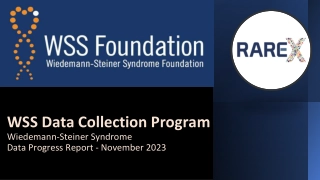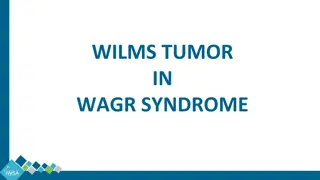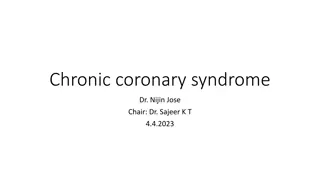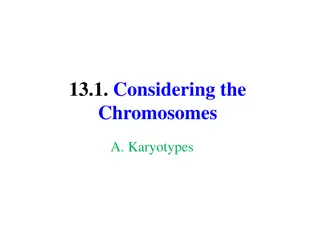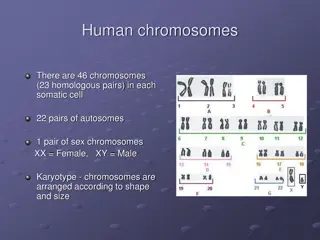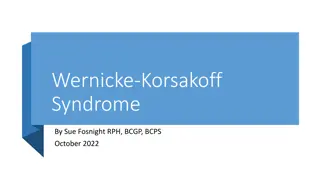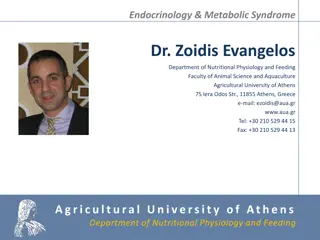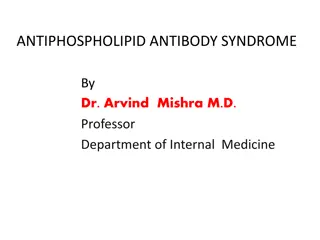Syndrome
Polycystic ovary syndrome is a common endocrine disorder in women, affecting menstrual cycles, fertility, and more. Learn about its prevalence, criteria for diagnosis, and pathophysiology.
Download Presentation

Please find below an Image/Link to download the presentation.
The content on the website is provided AS IS for your information and personal use only. It may not be sold, licensed, or shared on other websites without obtaining consent from the author.If you encounter any issues during the download, it is possible that the publisher has removed the file from their server.
You are allowed to download the files provided on this website for personal or commercial use, subject to the condition that they are used lawfully. All files are the property of their respective owners.
The content on the website is provided AS IS for your information and personal use only. It may not be sold, licensed, or shared on other websites without obtaining consent from the author.
E N D
Presentation Transcript
Polycystic Ovarian Syndrome Presented by :- Zahraa Abbas Asalla Taher Haider Mohammed Ali Mohammed Mustafa Machi
CASE 2 A ehs ,gninotiseuq rehtruf nopU .ehcranem ecnis selcyc ralugerri ynam rof enca dna riah laicaf ni esaercni na dection osla sah a sah dna smelborp lacidem fo yrotsih yna seined ehS .sraey si ehs ,notianimaxe nO .setebaid fo yrotsih lacidem ylimaf gnorts yrotaripser ,eslup ,)PB( erusserp doolb lamron a evah ot deton xedni ssam ydob a htiw esebo si ehS .erutarepmet dna ,etar sisohtnaca dna mstiusrih emos evah ot deton si ehS . si notianimaxe civlep reH .)shgiht renni dna kcen fo( snacirgin ycnangerp erised ton seod ehS .lamron tub ytisebo reh yb detimil evtiagen si tset ycnangerp reH .emti siht ta 23 fo stnialpmoc htiw ecffio eht ot stneserp elamef dlo - raey - fo )IMB( 34
Definition:- Polycystic ovary syndrome is the most common endocrine disorder to affect women during their reproductive years. The symptoms of PCOS include menstrual cycle disturbance and features of hyperandrogenism (hirsutism, acne, alopecia), with associated fertility problems, obesity and psychological issues.
EPIDEMIOLOGY AND PREVALENCE Estimates of the prevalence of PCOS are greatly affected by the nature of the population which is being assessed. The prevalence of PCOS varies depending on the criteria used for diagnosis. In the United States, polycystic ovarian syndrome (PCOS) is one of the most common endocrine disorders of reproductive-age women, with a prevalence of 4-12% In some European studies, the prevalence of PCOS has been reported to be 6.5-8%.
Criteria for diagnosis there are three major criteria, with two out of three required for diagnosis: Oligo- or anovulation Clinical and/or biochemical signs of hyperandrogenism (with the exclusion of congenital adrenal hyperplasia, Cushing s syndrome, androgen-secreting tumours, thyroid abnormalities and hyperprolactinemia) Polycystic ovaries on ultrasound.
Pathophysiology - Hypersecretion of androgens by the stromal theca cells of the polycystic ovary leads to the cardinal clinical manifestation of the syndrome, hyperandrogenism, and is also one of the mechanisms whereby follicular growth is inhibited with the resultant excess of immature follicles. - Hypersecretion of LH by the pituitary a result of both disordered ovarian pituitary feedback and exaggerated pulses of gonadotrophin- releasing hormone (GnRH) from the hypothalamus stimulates testosterone secretion by the ovary. - Furthermore, insulin is a potent stimulus for androgen secretion by the ovary, which, by way of a different receptor for insulin, does not exhibit insulin resistance. - Insulin therefore amplifies the effect of LH, and additionally magnifies the degree of hyperandrogenism by suppressing liver production of the main carrier protein, SHBG, thus elevating the free androgen index
The history 1- patient's pubertal history 2- the patient's menstrual and obstetric history 3- acne 4- developing unwanted hair or lost capital hair 5- Change weight , the pattern of the weight distribution, and the timing of the weight gain in relation to other symptoms
6- other features of the metabolic syndrome: hypertension, impaired glucose tolerance or type 2 diabetes mellitus 7-family history 8-change in the voice 9-increased muscle bulk, for example broadening of the shoulders
Examination 1-Measurement of height and weight should be performed in order to calculate the patient s body mass index (BMI). 2- Signs of hyperandrogenism acne, hirsutism, balding (alopecia) are suggestive of PCOS 3- Hirsutism can be graded and given a Ferriman Gallwey score by assessing the amount of hair in different parts of the body (e.g. upper lip, chin, breasts, abdomen, arms, legs). It is useful for monitoring the progress of hirsutism, or its response to treatment, by making serial records. 4- Acanthosis nigricans is a sign of profound insulin resistance and is usually visible as hyperpigmented thickening of the skin folds of the axilla and neck
Laboratory investigation Hormone levels Androgens Androgen excess can be tested by measuring total and free testosterone levels or a free androgen index .An elevated free testosterone level is a sensitive indicator of androgen excess. Other androgens, such as dehydroepiandrosterone sulfate (DHEA-S), may be normal or slightly above the normal range in patients with polycystic ovarian syndrome (PCOS). levels of sex hormone binding globulin (SHBG) are usually low in patients with PCOS.Androstenedione levels are also elevated in women with PCOS.
Follicle-stimulating hormone and luteinizing hormone levels FSH level should be checked to rule out primary ovarian failure. In patients with PCOS, FSH levels are within the reference range or low. LH levels are elevated for Tanner stage, sex, and age. The LH-to-FSH ratio is usually greater than 3.
Thyroid-stimulating hormone and free thyroxine levels Thyroid dysfunction, rather than PCOS, may be the source of amenorrhea and hirsutism. (In patients with PCOS, thyroid function tests are within the reference range.)
Glucose, insulin and lipid levels Because the prevalence of impaired glucose tolerance and type 2 diabetes mellitus is high in women with polycystic ovarian syndrome (PCOS) particularly those who have a body mass index (BMI) greater than 30 kg/m2, have a strong family history of type 2 diabetes, or are older than 40 years a 75-g oral glucose-tolerance test (OGTT) should be performed. A 2-hour postload glucose value of less than 140 mg/dL indicates normal glucose tolerance; a value of 140-199 mg/dL indicates impaired glucose tolerance; and a value of 200 mg/dL or higher indicates diabetes mellitus. Women diagnosed with prepregnancy PCOS should be screened for gestational diabetes before 20 weeks gestation. These women have a higher rate of gestational diabetes than women in the general population; therefore, refer them for expert obstetric diabetic consultation if abnormal results are found. Some women with PCOS have insulin resistance and an abnormal lipid profile (cholesterol >200 mg/dL; LDL >160 mg/dL). Approximately one third of women with PCOS who are overweight have impaired glucose tolerance or type 2 diabetes mellitus by 30 years of age.
Imaging studies of PCOS Ultrasonography Ovarian ultrasonography, preferably accomplished by using a transvaginal approach, can be performed to assess ovarian morphology. presence of 12 or more follicles (measuring 2 9 mm in diameter) in one or both ovaries and/or increased ovarian volume (greater than 10 cm3 ).
CT scan and MRI If a tumor is suspected, obtain a computed tomography (CT) scan or magnetic resonance image (MRI) to visualize the adrenals and ovaries. MRI is an excellent method for imaging the ovaries and is a useful alternative in very obese women in whom the ovaries might not be visualized with transvaginal ultrasonography (TVUS) and in those patients in whom TVUS is inappropriate, such as adolescent girls.
Treatment of PCOS Immediate / acute issues Hirsutism Obesity Regulation of menses Long term issues Insulin resistance Cardiovascular risk Obstructive sleep apnea Malignancy risk
Treatment Plan A- Education and counseling B- Life style modification C- Anti androgen treatment D- Management of metabolic syndrome F- Fertility treatment
PCOS Dietary Goals Reduce Consume more foods Total caloric fat rich in complex carbohydrate fibers monounsaturated fat omega-3 fatty acids Saturated fat Cholesterol
Treatment Plan A- Education and counseling B- Life style modification C- Anti androgen treatment D- Management of metabolic syndrome F- Fertility treatment
Anti Androgen Tx 1- Cyclical medroxyprogesterone 2- Combined oral contraceptive pills 3- Levenogestrel-releasing intrauterine system 4- Spirolactone
Treatment Plan A- Education and counseling B- Life style modification C- Anti androgen treatment D- Management of metabolic syndrome F- Fertility treatment
Management of Metabolic Syndrome 1- Screening for diabetes mellitus 2- Screening for dyslipidemia 3- Screening for hypertension 4- Screening for vitamin D deficiency and hypothyroidism
Metformin Metformin therapy is considered the initial intervention in the most women with PCOS , particularly in those who are overweight or obese Metformin improves many metabolic abnormality by increasing insulin sensitivity and improve menstrual cycle and the potential for pregnancy
Treatment Plan A- Education and counseling B- Life style modification C- Anti androgen treatment D- Management of metabolic syndrome F- Fertility treatment
Consensus on infertility treatment related to PCOS
Literature review Advances and challenges in PCOS understanding Metabolic profile Effect on pregnancy Polycystic ovarian morphology and the diagnosis of PCOS Advances and challenges in PCOS management
Advances and challenges in PCOS understanding Hyperandrogenism is the cardinal clinical manifestation of the syndrome, It is also one of the mechanisms whereby follicular growth is inhibited with the resultant excess of immature follicles. Hypersecretion Of LH due to: disordered ovarian pituitary feedback and exaggerated pulses of GnRH from the hypothalamus. This stimulates testosterone secretion by the ovary. Furthermore, insulin is a potent stimulus for androgen and also magnifies the degree of hyperandrogenism by suppressing sex hormone-binding globulin (SHBG) production, thus elevating the free androgen index.
Anti-Mllerian hormone (AMH) is a glycoprotein secreted by the granulosa cells of pre-antral and small antral follicles. A straightforward experimental study demonstrated that a significant subset of GnRH neurons both in mice and humans express the AMH receptor, and that AMH potently activates the GnRH neuron firing in mice and that intracerebroventricular administration of AMH increases GnRH-dependent luteinizing hormone (LH) pulsatile release 1. Increased LH pulsatility is an important pathophysiological feature in many cases of polycystic ovary syndrome (PCOS) 2, the most common cause of female infertility, in which circulating AMH levels are also often elevated 3. This finding raise the hypothesis that AMH-dependent regulation of GnRH release could be involved in the pathophysiology of fertility and could hold therapeutic potential for treating PCOS.
Metabolic profile Insulin resistance is so common in PCOS that it can be considered an integral part of the syndrome. It leads to compensatory hyperinsulinemia, which increases ovarian androgen synthesis both by direct ovarian actions and by stimulating LH secretion 4. In fact, recent studies show that hyperinsulinemia is present in 85% of patients with PCOS, including 95% of obese and 65% of lean affected women 5. A few biomarkers have been used to detect insulin resistance in PCOS women. Yet, different markers have variable sensitivities and specificities in insulin resistance testing 6. Thus, research is progressing to identify one universal marker for accurate diagnosis of decreased insulin sensitivity in patients with PCOS. If such a marker is identified, early detection of insulin resistance can lead to prompt treatment and prevention of any complications in the future.
Insulin resistance also induces dyslipidemia, and women with PCOS have an increased risk of type 2 diabetes mellitus and cardiovascular disease. One of the potential metabolic complication of PCOS is nonalcoholic fatty liver disease (NAFLD). PCOS is associated with increased risk of NAFLD regardless of the presence of obesity, suggesting that the relationship between PCOS and NAFLD is also explained by other features of PCOS, such as IR and androgen excess. a systematic review and meta-analysis which involved 17 studies published between 2007 and 2017 that included 2734 PCOS patients and 2561 controls of similar age and body mass index (BMI). showed a higher prevalence of NAFLD among women with hyperandrogenic phenotype compared to women with PCOS without hyperandrogenism, even after correction for confounding variables. while serum androgen levels were higher in PCOS women with NAFLD compared with PCOS women without NAFLD 7.
Effect on pregnancy In 1995, a study reported up to 50% and 25% of women in a PCOS population suffering from primary and secondary infertility respectively 8. More recently in 2015, a study by Hart and Doherty showed that infertility is 10 times more common among women with PCOS in comparison to healthy controls 9. On the other hand, some studies suggested that females with PCOS who conceive might suffer from pregnancy-related complications such as gestational diabetes 10, pregnancy induced hypertension 10, and preeclampsia 11to a higher extent in comparison to matched controls. Various research data also suggest an increased risk of miscarriage in women with PCOS 12,13
Polycystic ovarian morphology and the diagnosis of PCOS PCOM is one of three criteria for diagnosis of PCOS. PCOM is defined as follicle number per ovary of at least 12 or ovarian volume of at least 10 mL or both. However, the latest generation of ultrasound devices (maximal probe frequencies that exceed 8 MHz) is more sensitive and yields a larger follicle count in the general population; therefore, the current use of the old cutoff can overestimate the prevalence of PCOM 14. A group of experts recently proposed the use of higher in-house thresholds (that is, 19 to 25 follicles per ovary) to define PCOM with the new ultrasound machines 15. Serum AMH levels correlate with follicle number in women with PCOS. Some studies found a good concordance between serum AMH levels and ultrasound results for the diagnosis of PCOM. These studies suggest that serum AMH could be a proxy for ovarian follicle count and an alternative marker of PCOM to be used interchangeably with ultrasound depending on serum AMH and ovarian follicle count availability 16. Recent studies show that high levels of AMH (>35 pmol/L) have a good correlation with the diagnosis of PCOM at ultrasound 16. However, serum AMH levels should not yet be used as a marker or as a single test for the diagnosis and detection of PCOS 15,17.
Advances and challenges in PCOS management Metformin, an antidiabetic drug, improves insulin resistance and decreases hyperinsulinemia in patients with PCOS. This drug also has a small but beneficial effect on metabolic syndrome, as well as potentially causing a modest reduction in androgen levels (11%) 18. However, despite favourable physicochemical properties, oral administration of MTF-HCl is associated with impaired bioavailability (50-60%), lactic-acidosis and frequent dosing (500mg 2-3 times a day) in PCOS that ultimately influence the patient compliance and often has gastrointestinal side effects like nausea, vomiting, and diarrhea, a new pharmaceutical preparations especially designed for vaginal delivery are under development and so far have been effective in a preclinical model of PCOS 19.
Orlisat is a lipase inhibitor labeled for treatment of obesity. In overweight or obese women with PCOS, A meta-analysis showed that orlistat is effective to induce weight loss and improve clinical and biochemical markers of hyperandrogenism and insulin resistance with comparable results to metformin regarding BMI, HOMA, testosterone and insulin in overweight/obese PCOS women20.
Myo- and D-chiro-inositol are insulin-sensitizing agents that are involved in insulin signaling. Inositols Present in fruits and beans, they are incorporated into cell membranes as phosphatidyl-MI, which is a precursor of inositol triphosphate (InsP3). InsP3 is a second messenger for many hormones including insulin and follicle-stimulating hormone (FSH). Defects in this pathway can lead to impaired insulin signaling and cause insulin resistance. This is the rationale for the suggested use of inositols in the management of insulin resistance syndromes, including polycystic ovary syndrome (PCOS). They have been evaluated as possible alternatives to metformin in PCOS women with insulin resistance. Inositol isoforms mediate insulin activity in many target organs, including the ovary, as detailed in a recent review 21.
Clinical studies showed a decrease in serum testosterone along with an increase in SHBG levels after 6 months of treatment with myo-inositol alone or associated with D-chiro-inositol 22. Another study showed that both myo-inositol (MI-PG) and D-chiro inositol (DCI-PG) treatments are able to significantly improve the regularity of the menstrual cycle, the Acne Score, the endocrine and metabolic parameters and the insulin-resistence in young, overweight, PCOS patients 23.
However, New large trials are needed to assess and compare the effect of MYO-inositol and its various combinations to the classic PCOS medications and to check for any undetected long-term side effects. According to the International PCOS Network, inositol (in any form) should be considered an experimental therapy in PCOS.
References 1-Cimino I, Casoni F, Liu X, et al.: Novel role for anti-M llerian hormone in the regulation of GnRH neuron excitability and hormone secretion. Nat Commun. 2016; 7: 10055. 2-Katulski K, Podfigurna A, Czyzyk A, et al.: Kisspeptin and LH pulsatile temporal coupling in PCOS patients. Endocrine. 2018; 61(1): 149 57. 3- Brown ZA, Louwers YV, Fong SL, et al.: The phenotype of polycystic ovary syndrome ameliorates with aging. Fertil Steril. 2011; 96(5): 1259 65. 4- de Leo V, Musacchio MC, Cappelli V, et al.: Genetic, hormonal and metabolic aspects of PCOS: an update. Reprod Biol Endocrinol. 2016; 14(1): 38. 5- Teede H, Deeks A, Moran L. Polycystic ovary syndrome: a complex condition with psychological, reproductive and metabolic manifestations that impacts on health across the lifespan. BMC Med. 2010 Jun 30;8:41. doi: 10.1186/1741-7015- 8-41. PMID: 20591140; PMCID: PMC2909929. 6- Nawrocka-Rutkowska J, Cie wie S, Marciniak A, Brodowska A, Wi niewska B, Kotlega D, Starczewski A. Insulin resistance assessment in patients with polycystic ovary syndrome using different diagnostic criteria--impact of metformin treatment. Ann Agric Environ Med. 2013;20(3):528-32. PMID: 24069859. 7- Rocha ALL, Faria LC, Guimar es TCM, et al.: Non-alcoholic fatty liver disease in women with polycystic ovary syndrome: systematic review and meta-analysis. J Endocrinol Invest. 2017; 40(12): 1279 88. 8- Balen AH, Conway GS, Kaltsas G, Techatrasak K, Manning PJ, West C, Jacobs HS. Polycystic ovary syndrome: the spectrum of the disorder in 1741 patients. Hum Reprod. 1995 Aug;10(8):2107-11. doi: 10.1093/oxfordjournals.humrep.a136243. PMID: 8567849. 9- Hart R, Doherty DA. The potential implications of a PCOS diagnosis on a woman's long-term health using data linkage. J Clin Endocrinol Metab. 2015 Mar;100(3):911-9. doi: 10.1210/jc.2014-3886. Epub 2014 Dec 22. Erratum in: J Clin Endocrinol Metab. 2015 Jun;100(6):2502. PMID: 25532045. 10- Bruyneel A, Catteau-Jonard S, Decanter C, Clouqueur E, Tomaszewski C, Subtil D, Dewailly D, Robin G Gynecol Obstet Fertil. 2014 Feb; 42(2):104-111. 11- Katulski K, Czyzyk A, Podfigurna-Stopa A, Genazzani AR, Meczekalski B. Pregnancy complications in polycystic ovary syndrome patients. Gynecol Endocrinol. 2015 Feb;31(2):87-91. doi: 10.3109/09513590.2014.974535. Epub 2014 Oct 30. PMID: 25356655. 12- Wang JX, Davies MJ, Norman RJ. Polycystic ovarian syndrome and the risk of spontaneous abortion following assisted reproductive technology treatment. Hum Reprod. 2001 Dec;16(12):2606-9. doi: 10.1093/humrep/16.12.2606. PMID: 11726582.
13- Winter E, Wang J, Davies MJ, Norman R. Early pregnancy loss following assisted reproductive technology treatment. Hum Reprod. 2002 Dec;17(12):3220-3. doi: 10.1093/humrep/17.12.3220. PMID: 12456627. 14- Martins WP, Kollmann M, Raine-Fenning N: Counting ovarian follicles: updated threshold for diagnosis of hyperandrogenic anovulation. Ultrasound Obstet Gynecol. 2014; 44(2): 131 4. 15- Dewailly D, Lujan ME, Carmina E, et al.: Definition and significance of polycystic ovarian morphology: a task force report from the Androgen Excess and Polycystic Ovary Syndrome Society. Hum Reprod Update. 2014; 20(3): 334 52. 16- Fraissinet A, Robin G, Pigny P, et al.: Use of the serum anti-M llerian hormone assay as a surrogate for polycystic ovarian morphology: impact on diagnosis and phenotypic classification of polycystic ovary syndrome. Hum Reprod. 2017; 32(8): 1716 22. 17- Teede HJ, Misso ML, Costello MF, et al.: Recommendations from the international evidence-based guideline for the assessment and management of polycystic ovary syndrome. Hum Reprod. 2018; 33(9): 1602 18. 18- Royal College of Obstetricians and Gynaecologists. Long-term consequences of polycystic ovary syndrome. London, UK: Royal College of Obstetricians and Gynaecologists; 2007. Green-top guideline; no. 33. 19- Saini N, Sodhi RK, Bajaj L, et al.: Intravaginal administration of metformin hydrochloride loaded cationic niosomes amalgamated with thermosensitive gel for the treatment of polycystic ovary syndrome: In vitro and in vivo studies. Colloids Surf B Biointerfaces. 2016; 144: 161 9. 20- Graff SK, Mario FM, Ziegelmann P, Spritzer PM. Effects of orlistat vs. metformin on weight loss-related clinical variables in women with PCOS: systematic review and meta-analysis. Int J Clin Pract. 2016 Jun;70(6):450-61. doi: 10.1111/ijcp.12787. Epub 2016 May 26. PMID: 27228266. 21- Monastra G, Unfer V, Harrath AH, et al.: Combining treatment with myo-inositol and D-chiro-inositol (40:1) is effective in restoring ovary function and metabolic balance in PCOS patients. Gynecol Endocrinol. 2017; 33(1): 1 9. 24- Formuso C, Stracquadanio M, Ciotta L. Myo-inositol vs. D-chiro inositol in PCOS treatment. Minerva Ginecol. 2015 Aug;67(4):321-5. Epub 2015 Feb 11. PMID: 25670222.
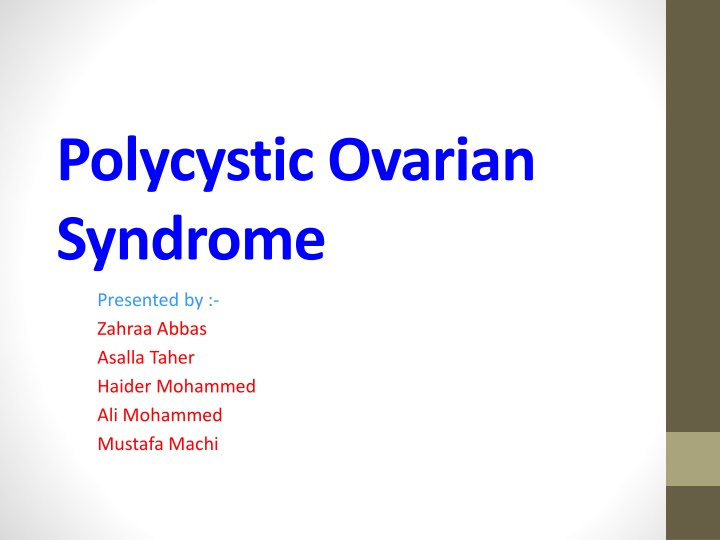


![❤[PDF]⚡ Zee Zee Does It Anyway!: A Story about down Syndrome and Determination](/thumb/20462/pdf-zee-zee-does-it-anyway-a-story-about-down-syndrome-and-determination.jpg)
